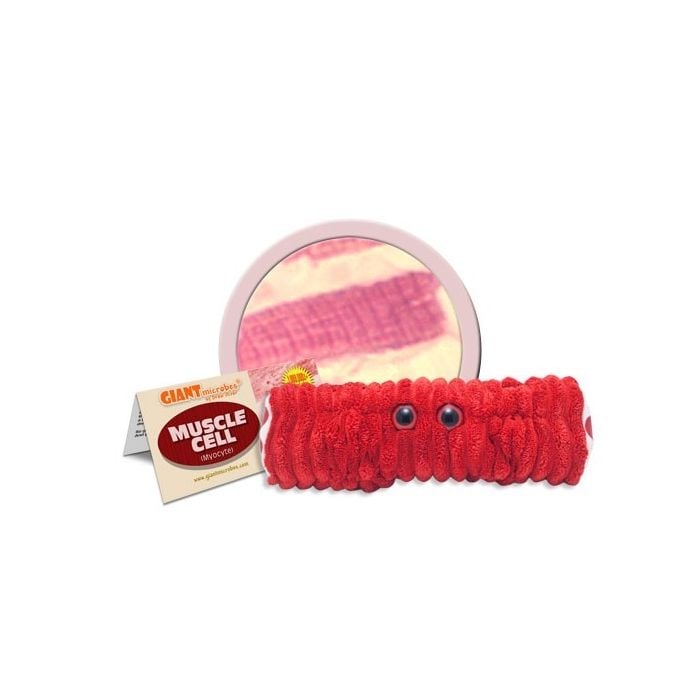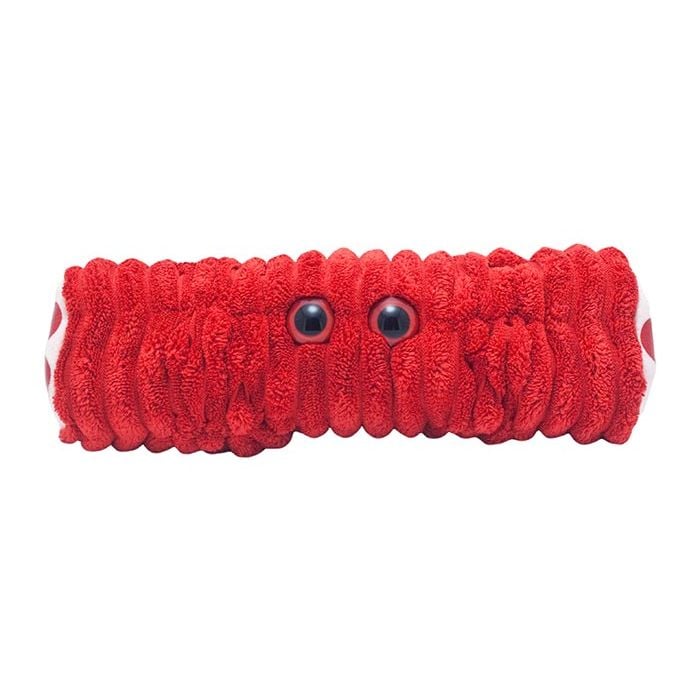Muscle Cell (Myocyte)
Out of Stock
Our muscle cell expands and contracts like a real muscle!
Product Details
Additional Information
| Sizes | Giantmicrobes are based on actual microbes, cells, organisms and other critters, only 1,000,000 times actual size! Gigantic (GG) 40-60cm XL (XL) 25-38cm Original (PD) 12-20cm Minis (MM) 5-10cm each Keychain (KC) 5-10cm with clip |
|---|---|
| Materials | Plush from all new materials. Stuffed with polyester fiber fill. Surface washable: sponge with water & soap, air dry. |
| Packaging | Each plush microbe includes a printed card with fun, educational and fascinating facts about the actual microbe or cell. |
| Safety | Every product meets or exceeds U.S. and European standards for safety. For ages 3 and up. |
All about Muscle Cell (Myocyte)
FACTS: There are three kinds of muscle cells: cardiac (the involuntary thumping muscles found in the heart), smooth (the involuntary muscles such as those that line blood vessels, the gastro-intestinal tract, and the lungs) and skeletal (the familiar muscles attached by tendons to bones). But skeletal muscle cells are the most common. They represent the bulk of the soft tissue in animals.
Like a strong cable, skeletal muscles are made up of smaller and smaller fibrous tissues. Bundles of fascicles comprise groups of muscle fibers, which in turn are made up of tubular myofibrils containing tiny protein filaments. At the molecular level, these filaments contract ever so slightly. But working together as part of a team, these tiny contractions add up to produce a force great enough to lift a bolder (or gentle enough to hold a butterfly’s wing).
Muscles are typically red because they are saturated with the energy-carrying blood required to do their work. However, “white” fast-twitch muscle can produce a large force for very short periods. This muscle type is often prevalent in small creatures which need to escape predators (such as rodents and fish), and it accounts for their white flesh.
Of course, even if you don't expect to be escaping from predators, it's important to stay in shape. By exercising, you can train your individual muscle cells to work together more efficiently, and over time you can also increase the number of contractile proteins in your body for even greater strength. Finally, because your muscles are constantly metabolically active, the more muscular you are, the easier it is to keep in shape.
| Description |
Muscle cells are responsible for contraction, which cause the movements of and within the human body. This is a cute gift for your friend who likes to exercise! Bro, do you even lift? Types: Skeletal muscle: is voluntary, meaning you decide how and when to move it. It is striated, meaning it appears striped with darker and lighter sections under a microscope. The cells also have multiple nuclei, caused by the fusion of smaller muscle cells as a fetus. This type of muscle is found on the skeleton, and it allows the body to run and write and throw. Cardiac muscle: is involuntary, meaning you don’t have to think about it for it to function. It is striated like skeletal muscle, however the cells only have one nucleus. This type of muscle is found in the heart and it helps the heart to pump blood. Smooth muscle: is involuntary, not striated, and the cells have one nucleus. This type of muscle is found in the internal organs, so it is responsible for moving and contracting the stomach, bowels, and blood vessels. |
|---|
| Name | Come from the Greek: Myo=muscle, Cyte=cell |
|---|
| Actual Size |
Skeletal: They are about as long as the muscle they are in, which can be many centimeters. The diameter is about 50 micrometers. Cardiac: The length is about 0.1mm while it is about 0.02mm wide. Smooth: The length is between 50-200 microns whereas the width is 2-10 microns. Overall, the ratio of the widths to the lengths indicates that muscle cells are long and lean, just like you after hitting the gym! |
|---|
| System | Muscles are found all throughout the body and are a crucial part of many systems. Some examples include the musculoskeletal system (skeletal muscle), digestive system (smooth muscle), and the cardiovascular system (cardiac muscle). |
|---|
| Quantity | There are about 2 billion cardiac muscle cells, and 605 skeletal muscles. |
|---|
| History |
1864: Kühne extracted a protein from muscle, myosin, which is responsible for muscle contraction. 1939: Engelhardt and Ljubimowa figured out that myosin used ATP as the energy source for muscle. |
|---|
| Fascinating Facts |
Multiple Nuclei: Skeletal muscle cells can contain as many as 100 nuclei! Heavy: Skeletal makes up about 40% of a person’s body mass. Muscles in Life: Big (skeletal) muscles are representative of macho-ness and strength. Pumping Iron: This 1977 movie starring Arnold Schwarzenegger depicts bodybuilders preparing for Mr. Olympia and Mr. Universe contests. Old Spice Commercial: Terry Crews, muscle man extraordinaire, stars in an Old Spice commercial where his muscles are connected to instruments, and he plays music by flexing! |
|---|







